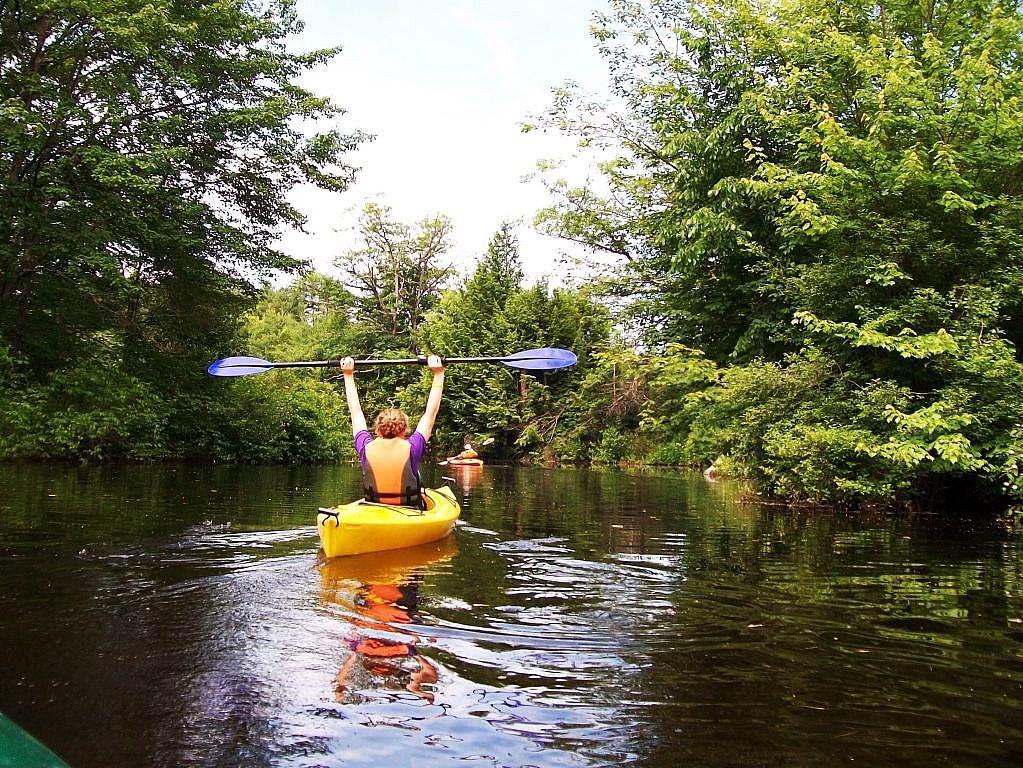
Monitoring Water Quality
Newfound Lake has exceptional water quality, and we're working hard to keep it that way! Through regular monitoring, we track changes in water quality to inform our conservation efforts.
Current Water Quality Conditions
Our 40 years of data show that, while Newfound Lake can be harmed by increasing watershed development and intense storms that trigger stormwater pollution, overall water quality remains high.
Newfound Lake's water quality is measured weekly from mid-May through September at seven monitoring sites. Water quality monitoring is made possible by volunteers and support from organizational partners. Learn more about volunteering.
Conditions for September, 2025

| Monitoring Site | Water Clarity | Surface Temperature | Depth to Thermocline | Thermocline Temperature |
| 1. Loon Island | 31.8' | 7.2°F | 27.9’ | 67.8°F |
| 2. Cockermouth | 28.2' | 68.7°F | 26.2' | 66.4°F |
| 3. Beechwood | 31.5' | 68.4°F | 31.2' | 67.3°F |
| 4. Pasquaney Bay | 34.1' | 69.4°F | 24.6' | 68°F |
| 5. Deepest Point | 27.2' | 68.9°F | 29.5' | 68°F |
| 6. Follansbee Cove | 33.8' | 67.1°F | 31.2' | 66°F |
| 7. Mayhew | 25.3' | 69.3°F | 22.9' | 66.9°F |
Understanding Current Conditions
Water Clarity
Clarity is measured by lowering a black and white Secchi disk in the water until it disappears from view. Deeper readings mean clearer water, which is a sign of fewer pollutants and less algae. Shifts in clarity can indicate changes in runoff pollution, stormwater impacts, or algae growth.
Surface Temperature
Surface temperature affects more than just swimming conditions. Warmer water speeds up algae growth , changes the chemistry of the upper layer of hte lake, and can stress cold-water fish. Tracking surface temperatures helps us understand how climate and weather events affect the lake season by season. Cooler temperatures are generally healthier for the lake.
Thermocline Depth
The thermocline is the sharmp boundary between warm surface water and the colder, denser water beneath. Its depth matters because it defines the habitat zones in the lake: algae and plankton thrive above it, while many fish depend on the cool, oxygen-rich waters below.
Temperature at the Thermocline
Measuring the temperature at the thermocline tells us how suitable the deeper waters are for fish and other species. If deep waters get too warm, or lose oxygen, it means there is less cold-water habitat for aquatic life.
2024 Lake Water Quality Summary
In 2024, volunteer lake monitors collected the most comprehensive set of water samples ever taken on Newfound Lake. Their data show encouraging signs of recovery after 2023’s storms, with clearer water and lower phosphorus levels across the lake. Here are the key takeaways from our 2024 water quality data:
- Clearer water. Water clarity improved throughout the season.
- Less phosphorus. A key nutrient that fuels algae growth decreased lakewide.
- No harmful algal blooms. While statewide reports of cyanobacteria increased, none were detected in Newfound.
- No new aquatic invasive species. Lake Hosts inspected 1,704 boats and Weed Watchers surveyed 100% of the shoreline, finding no invasive aquatic species that could harm water quality.
Still, challenges remain. Drought and heat in 2024 led to warmer surface waters and lower dissolved oxygen, conditions that can favor algae and bacteria growth. Chlorophyll a levels (a measure of algae and bacteria) were elevated, though they declined through the summer.
| Water Quality Parameter | NH High Quality Standard | 10 Year Median | 2023 Median | 2024 Median |
| Water Clarity (ft) | >13.1 | 27.2 | 21 | 25.5 |
| Total Phosphorus (ppb) | <8 | 4.05 | 5.6 | 3.9 |
| Chlorophyll A (ppb) | <3.3 | 1.91 | 1.82 | 1.73 |
2025 State of the Lake Presentation
Conservation Program Manager Paul Pellissier discusses NLRA's latest water quality data, the results of expanded invasive aquatics monitoring, new water quality targets, and more in this remote presentation held on March 4, 2025.
Long-Term Trends
Newfound’s centrally located deepest point best represents lake-wide trends in water quality. We carefully assess data from the "Deep Site" for long-term trends to understand what’s happening in the entire lake over time.
Interpreting this Figure
This figure shows individual readings of water clarity (blue dots) taken during the summer from 1978 to the present. The solid black line is a statistically fitted trendline and the grey shading describes how well the trendline fits the data.
Note: In areas with more data, the shading tends to be narrower, indicating a more accurate placement of the trendline.
Why Phosphorus is Important
Phosphorus is the key nutrient controlling the growth of freshwater plants and algae. It occurs naturally in soils, but human activities like applying fertilizers and failing septic systems have a significant contribution. Impervious surfaces associated with development also concentrate stormwater runoff, leading to increased erosion and the transport of phosphorus in soils to the lake. More phosphorus leads to increased algae and decreased water quality.
A Pigment You Should Know
Chlorophyll a is a light-absorbing pigment naturally found in all green plants and algae that convert the sun’s energy into food through photosynthesis. It is one of the most abundant chemical compounds on earth! Levels below 3.3 parts per billion (ppb) are best for lakes like Newfound.
Historic Declines in Water Quality
Deep Site measurements of transparency, chlorophyll a, and total phosphorus all show signs of declining water quality from the beginning of our record in the mid 1980s through the late 1990s. During this period, we saw an increase in chlorophyll a, total phosphorus, and a 13-foot (3.9 m) decrease in average summer water transparency at the Deep Site, with similar trends observed at other monitoring sites.
While it is often difficult to attribute direct causes of changing water quality in lake systems, the connection between increasing development and declining water quality is well documented in scientific literature. The 1980s saw an increase in development in the watershed and Newfound experienced several major storm events throughout the 1990s, moving sediment and pollution into the lake. Pollution carried in stormwater runoff from developed areas is Newfound’s largest threat.
Slow and Steady Rebound
Throughout the early 2000s we saw a period of steady improvement across the three measures of water quality with clarity and chlorophyll a approaching levels seen in the mid 1980s and total phosphorus decreasing to 4 parts per billion (ppb).
Impact of Intense Storms
The recent water quality record is dominated by the influence of several large storm events, starting with Tropical Storm Irene in 2011 which brought over 8 inches of sustained rain to the watershed. Its damaging flood waters carried sediment and stormwater pollution to Newfound—dropping lake transparency by 80% to just 6.9 feet (2.1 m). Irene’s legacy can clearly be seen in the transparency and chlorophyll records and impacted water quality for at least the next four years. Intense storms occurring throughout 2023 have negatively impacted water quality lake wide. Looking at Newfound’s water quality record we see the effects from seasons like 2023 lasting for several years but generally do not alter long-term trends.
Water Quality Threats

Stormwater Runoff
With climate change driving more frequent severe storms, stormwater runoff is the biggest threat to Newfound's water quality.

Aquatic Invasive Species
Aquatic invasive species harm water quality and lake habitats. NLRA works to stop aquatic invasive species from entering Newfound Lake, and you can help!
Building Resilience
NLRA programs and initiatives work to ensure clean water by protecting healthy ecosystems through thoughtful stewardship of natural resources at a variety of scales.

Watershed Planning
A watershed plan is a strategy for achieving water resource goals. Watershed planning is a community-driven process addressing watershed-wide problems to protect water resources.

Stormwater Management
Stormwater management projects protect the waters of Newfound Lake and its tributaries from pollution while also protecting our roads, homes, and infrastructure from damage and erosion.

Land Conservation
Thoughtful land conservation is the most effective way to protect water quality. Undeveloped land acts as a filter, stopping pollution before it reaches our waterways.

Aquatic Invasive Species Monitoring
NLRA's volunteer Weed Watchers monitor Newfound Lake for invasive aquatic plants, while the Lake Host program prevents the spread of invasives with complimentary boat checks at Newfound's public boat launches.

Education and Community Engagement
By educating and engaging our community we can ensure a continued tradition of stewardship in the Newfound Watershed. NLRA offers programs and events for all ages.
Get Involved

Volunteer
Give yourself an excuse to get out on the lake and along the streams. Become a water quality monitor, watch for invasive species, and more!

Prevent Stormwater on Your Property
Prevent stormwater runoff from damaging your property and the Lake. We can help!

Become a Member
Our year-round work is made possible by the support of our members. Join the NLRA community and protect what you love.















